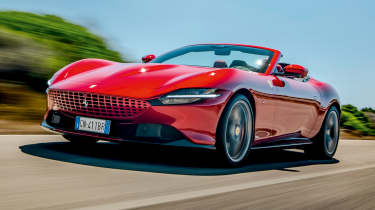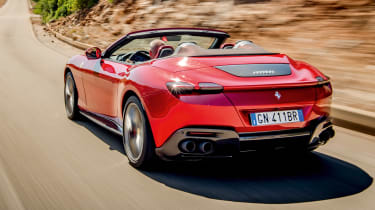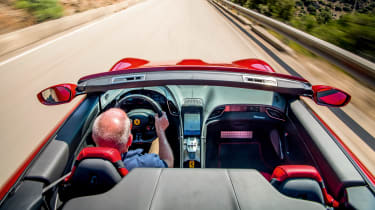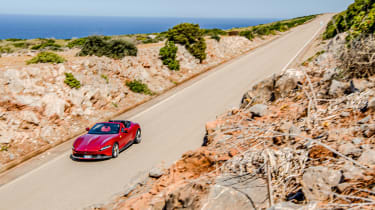Ferrari Roma Spider 2024 review – can it capture the coupe's brilliance?
Forget the California. With this new open-top version of the Roma, Ferrari at last has an entry-level convertible it can be proud of
The Ferrari Roma Spider has been six years and three CEOs in the making and it’s all the California’s fault. Poor thing can’t catch a break even when it’s been off sale for over half a decade. The car destined to be a Maserati, but which proved too costly for the Trident badge to carry off, soon became a Ferrari to wow and woo first-time customers who weren’t ready for something mid-engined or with a V12 behind its grille. And it worked: 70 per cent of the 17,500 people who bought Californias were new to the brand.
Yet for some at Ferrari it dragged the marque down to a level they didn’t feel comfortable with, then-CEO Sergio Marchionne telling the assembled media at the 2017 Geneva motor show that the model needed a rethink beyond the 2018 update that resulted in the introduction of a turbocharged V8, a design nip and tuck and some revisions to the chassis.
> Ferrari Purosangue review – there's no SUV quite like it
That car, rebadged as Portofino and launched under Louis Camilleri’s tenure as CEO, went some way to making amends, the updated M version introduced in 2021 further still, proving that a 2+2, front-engined hard-top convertible could wear Prancing Horse shields on its flanks with some pride. But still it was felt the entry point to Ferrari ownership needed to be, well, a little more Ferrari. This is where the Roma came in in 2020 in coupe form. And now, with the Spider, it takes over the ‘2+’ convertible position in the line-up too, the Portofino M order booked long since closed and the final examples being assembled under the current CEO, John Elkann.
More reviews
With development starting after the Roma coupe’s launch, the Spider transformation has required a little more work than simply finding a solution to replacing the fixed roof while retaining the simple, ’60s-inspired design of the car overall. Basking in late-summer sun the latest Spider certainly exudes an elegance and simplicity of design that was lacking in both of its predecessors. It has a more confident posture and, crucially, is more comfortable on the eye. It blends modern attributes with the clarity of yesterday’s design crispness without falling into the pastiche trap of trying to be modern while hauling old baggage around.
A switch from a folding metal roof to a canvas one has been of great help to its looks. Not only does the soft-top, according to Ferrari, provide a more warming approach to the car’s design compared to the technical and cold style of a folding metal roof, but it also eliminates the packaging issues that a folding hard-top creates, which resulted in the bulky and heavy-handed rear design that afflicted both the California and the Portofino. For the Spider the canvas roof only partially slips away out of sight, allowing the Roma to keep its hips trim and in shape. This new roof and the requirement for additional stiffening along each sill, the A-pillars and boot floor account for the Spider’s 84kg weight gain over the coupe.
Such is the ferocity of the Roma’s twin-turbocharged V8 that the weight gain is neither here nor there, both in a straight line and through the more interesting sections of road. The 611bhp that arrives with a bang at 5750rpm gives the V8 its screaming head as it rampages through to the 7500rpm peak, shift lights racing through to the red zone. Each upshift of the eight-speed dual-clutch transmission rips through with intense energy, landing you in the heart of the engine’s 560lb ft of torque as you set off in a bid to reach the horizon once again. It’s intoxicating, frantic and mesmerising as only the best engines are able to be.
In a world of hybrid assistance and torque fill, the Roma Spider’s V8 feels moderately old-school in its set-up, but it remains a mighty power unit with a wide operating window that allows the car to play its dual GT-supercar role. With 80 per cent of its torque available from a lowly 1900rpm the Spider is always on with its senses primed, although in Comfort mode and with the gearbox left in auto there can be times when you’re expecting quicker downshifts when you spot an opportunity to pass slower traffic or need to make progress, but they don’t come. The need to reduce emissions means the time it takes for the command from your right foot to result in the desired forward propulsion has an unexpected lag to it. Twist the manettino round to Sport and the issue is eradicated. Switch the eight-speed to manual and interact with the brilliant paddles and you’ll never give it another thought.
In its transition from coupe to Spider the Roma’s control systems for the engine and gearbox responses have been adjusted only to match the increased weight; there are no changes to adapt the car’s characteristics. The same approach has been taken with the Spider’s chassis. The spring rates remain the same as the coupe’s, so too the core settings for the active damper system. What has been altered is how the dampers react, to compensate for the weight increase; while the weight gain may equate to no more than always driving with a passenger in a Roma coupe, the change in weight distribution called for more detailed finessing.
As a result there’s a softer edge to the Spider when the dampers are in their mildest setting, with more pitch and roll on turn-in, more compression to lean on through a corner, and a rear that squats harder before settling. However, as with the powertrain, wind the chassis up to Sport and the Spider connects to become sharper, more responsive and lighter on its toes. Ferrari’s ‘bumpy road’ damper setting, while still a marvel, isn’t always required either, due to the more measured fluidity the Spider delivers.
Before committing to a turn you’re struck by steering that is very un-Ferrari-like. Where we have become used to super-quick reactions from the company’s mid- and V12-engined cars when it comes to steering inputs, with a light but direct weighting, the Roma Spider’s steering is appreciably slower and heavier (heavy for Ferrari that is). It suits the Spider’s nature better, the calmer actions more measured and requiring a less laser-focused approach to every fourth-gear sweeper or city roundabout. When pushed and with the systems set to ‘let’s see what it will do for the camera’ mode, there’s a wide sweet spot of balance to work with before you need to be quick with your hands and the throttle. Perfect for those experiencing their first Ferrari before they strap themselves into a 296 GTS.
Another difference on our test car from the coupe Romas we’ve driven before is the tyres. The coupe was launched with the choice of Michelin’s Pilot Sport 4 S or Pirelli’s P Zero, neither of which had been through a dedicated tyre development programme specific to the Roma, only Ferraris in general. While these are still available, both coupe and Spider can now be had with a Bridgestone Potenza Sport that has been developed specifically for the model. However, where the French and Italian rubber provided the response, crispness and stability expected of a 611bhp, rear-drive Ferrari, the Bridgestone lacks precision and feedback. You can feel the tyre roll on its treadblocks during the initial turn-in phase before it settles and starts to work its grip, and while it’s doing so you’re getting muffled messages through the steering, resulting in a moment of uncertainty in your mind as to whether you need to apply more or less lock. Trust your instincts and the Spider responds accordingly, but let your confidence slip and either apply an additional degree or two of lock or wind some off and you inject uncertainty that requires further management from the driver’s seat. It’s not unruly, far from it, and it’s only at higher speeds when firmer commitment is required, but it reduces your focus until you’re confident that you have secured a bond between you, the car and its Bridgestones.
The Ferrari Roma Spider, like its predecessors, isn’t a car in which to set a lap record at Fiorano (or any circuit for that matter), and when you dial the speed back and allow it to settle to its natural rhythm it makes for an absorbing driving experience, roof up or down – although down feels more special even if the sound from the outside offers little to write home about.
The 2+ concept of the Spider means the rear seats are best used for carrying objects rather than people, and should you want to benefit from the innovative wind deflector the rear buckets are only useful for bag storage anyway. This is because the deflector is also the backrest for the rear seats, which arcs upwards to provide an extension to the rear deck that mostly covers the space above the back seats. An opening at the deflector’s trailing edge then draws turbulent air in and away from the cabin. It’s remarkably effective, too. Roof down, windows up and deflector in place the cabin is calmer and quieter than being in a fixed-roof car with its sunroof tilted open. Drop the windows and there’s little additional buffeting over a rival convertible with its roof down and windows up. If you have the hairpiece to do so you can travel all day with the roof down, deflector up (but stay below 105mph) and suffer no ill effects.
You might be driven mad by the HMI system, however. Never a strong point in modern Ferraris, some upgrades have been carried out to improve the interface and the driver interaction. The steering wheel buttons are now recessed in the spokes of the wheel, but there still remains a great number of controls on the wheel that need to return to their natural positions. And the touchscreen, while less laggy and not so counterintuitive, remains only a mild improvement on what’s gone before. But even some within Ferrari admit the company needs to look at how it designs and presents its control interfaces on future models.
The Roma Spider is also the recipient of the latest Advanced Driver-Assistance System (ADAS), which includes lane-keep assist that will become mandatory from summer 2024 on all new cars sold. Thankfully Ferrari provides a shortcut to turning the hateful software off, and even a way to configure and fine-tune the ADAS to suit your requirements.
There is plenty to like about the Roma Spider, a great deal in fact. It feels bespoke in that way only Ferraris do, with distinct character traits that deliver an all-encompassing and rewarding experience. That it appears to suffer next to no downsides over the coupe from having its roof removed only goes to strengthen its appeal. Factor in that it’s as punchy as a Porsche 911 Turbo S Cabriolet against the clock and on the road, and as elegant as Aston Martin’s DB12 Volante, and the entry-level Ferrari conundrum could be solved once and for all.
Price and rivals
In the UK Roma Spider prices start from £210,313, over £27,000 more than a Roma coupe. Aston Martin’s DB12 Volante is also expected to cost over £200,000 when it arrives later this year.
Bentley’s Continental GT convertible starts at £204,460 but is a very different driving proposition to the Ferrari (and Aston for that matter), focusing on luxury and opulence over dynamics and engagement. Whereas Porsche’s 911 Turbo S Cabriolet couldn’t be more different from the Bentley and looks a relative bargain at £190,600. Talking of genuine bargains, Lexus’s LC500 convertible (£109,685) might not be the obvious rival to these more illustrious European brands, but its naturally-aspirated V8, sharp design and high-quality interior (and genuine exclusivity) makes for a leftfield alternative.
Ferrari Roma Spider specs
| Engine | V8, 3855cc, twin-turbo |
| Power | 611bhp @ 5750-7500rpm |
| Torque | 560lb ft @ 3000-5750rpm |
| Weight | 1556kg (dry) (399bhp/ton) |
| 0-62mph | 3.4sec |
| Top speed | 199mph |
| Basic price | £210,313 |








